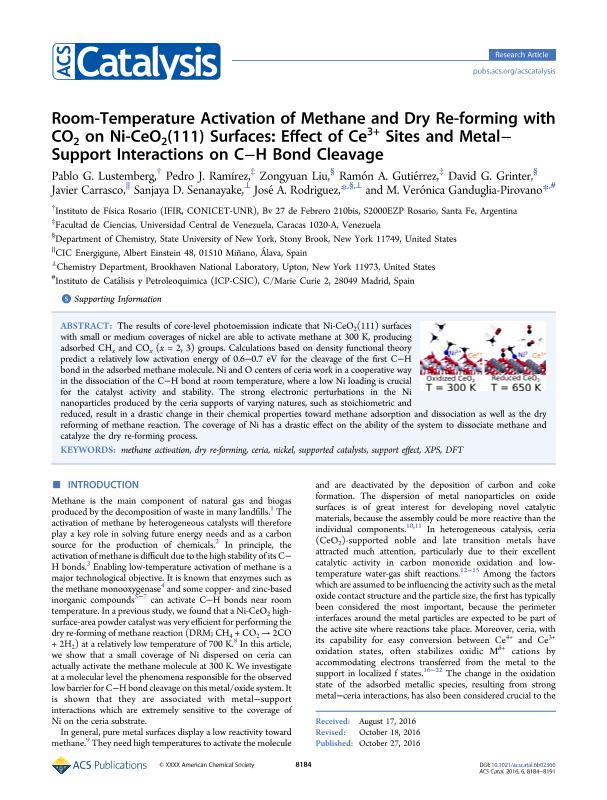Artículo
Room-Temperature Activation of Methane and Dry Re-forming with CO2 on Ni-CeO2(111) Surfaces: Effect of Ce3+ Sites and Metal-Support Interactions on C-H Bond Cleavage
Lustemberg, Pablo German ; Ramírez, Pedro J.; Liu, Zongyuan; Gutiérrez, Ramón A.; Grinter, David G.; Carrasco, Javier; Senanayake, Sanjaya D.; Rodriguez, José A.; Ganduglia Pirovano, Maria Veronica
; Ramírez, Pedro J.; Liu, Zongyuan; Gutiérrez, Ramón A.; Grinter, David G.; Carrasco, Javier; Senanayake, Sanjaya D.; Rodriguez, José A.; Ganduglia Pirovano, Maria Veronica
 ; Ramírez, Pedro J.; Liu, Zongyuan; Gutiérrez, Ramón A.; Grinter, David G.; Carrasco, Javier; Senanayake, Sanjaya D.; Rodriguez, José A.; Ganduglia Pirovano, Maria Veronica
; Ramírez, Pedro J.; Liu, Zongyuan; Gutiérrez, Ramón A.; Grinter, David G.; Carrasco, Javier; Senanayake, Sanjaya D.; Rodriguez, José A.; Ganduglia Pirovano, Maria Veronica
Fecha de publicación:
12/2016
Editorial:
American Chemical Society
Revista:
ACS Catalysis
ISSN:
2155-5435
Idioma:
Inglés
Tipo de recurso:
Artículo publicado
Clasificación temática:
Resumen
The results of core-level photoemission indicate that Ni-CeO2(111) surfaces with small or medium coverages of nickel are able to activate methane at 300 K, producing adsorbed CHx and COx (x = 2, 3) groups. Calculations based on density functional theory predict a relatively low activation energy of 0.6-0.7 eV for the cleavage of the first C-H bond in the adsorbed methane molecule. Ni and O centers of ceria work in a cooperative way in the dissociation of the C-H bond at room temperature, where a low Ni loading is crucial for the catalyst activity and stability. The strong electronic perturbations in the Ni nanoparticles produced by the ceria supports of varying natures, such as stoichiometric and reduced, result in a drastic change in their chemical properties toward methane adsorption and dissociation as well as the dry reforming of methane reaction. The coverage of Ni has a drastic effect on the ability of the system to dissociate methane and catalyze the dry re-forming process.
Archivos asociados
Licencia
Identificadores
Colecciones
Articulos(IFIR)
Articulos de INST.DE FISICA DE ROSARIO (I)
Articulos de INST.DE FISICA DE ROSARIO (I)
Citación
Lustemberg, Pablo German; Ramírez, Pedro J.; Liu, Zongyuan; Gutiérrez, Ramón A.; Grinter, David G.; et al.; Room-Temperature Activation of Methane and Dry Re-forming with CO2 on Ni-CeO2(111) Surfaces: Effect of Ce3+ Sites and Metal-Support Interactions on C-H Bond Cleavage; American Chemical Society; ACS Catalysis; 6; 12; 12-2016; 8184-8191
Compartir
Altmétricas



